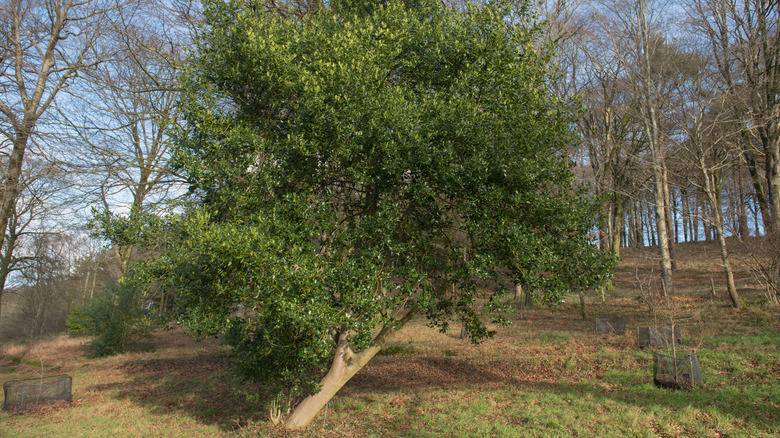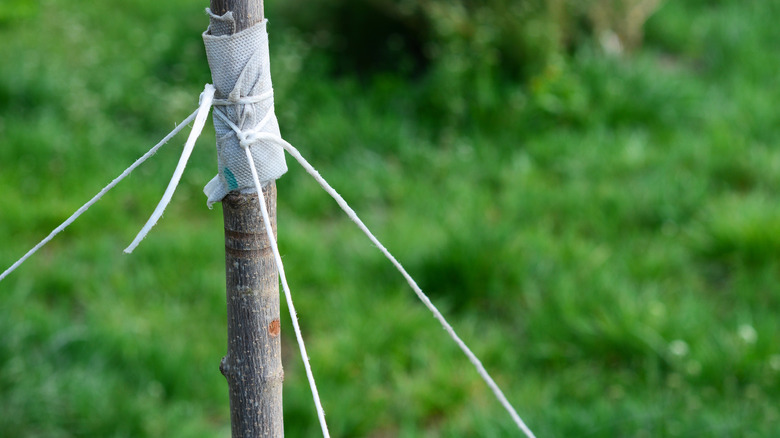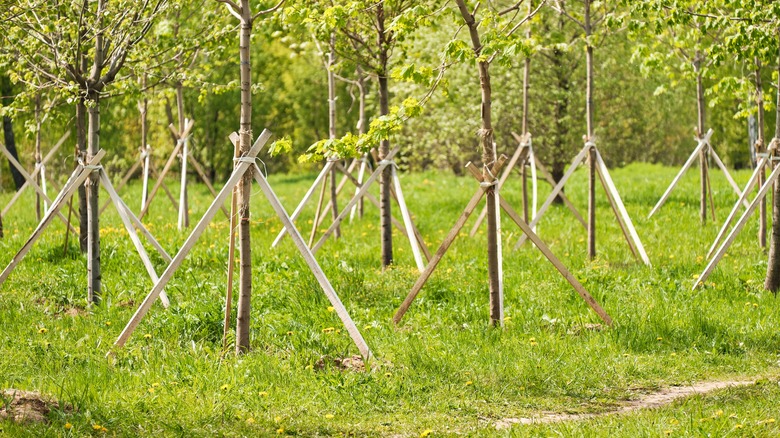Here's How To Straighten A Leaning Tree In Your Yard
There's little doubt trees add a lot of benefits to a home's landscape, including shade that can reduce energy costs and a beautiful aesthetic. You may be concerned if you've recently planted a tree and it doesn't seem to be growing all that straight. Most of the time, it's possible to use a stake and some rope to help straighten out the tree, getting it back on track to reach for the sky.
Doing so is important. A tree that isn't growing properly can be an eyesore but can also be a safety risk, especially if its roots cannot become stable enough to support it over time. You certainly want to take steps to encourage proper growth for your new investment, too. There's no need to cut it down or to dig it up, though. In most situations, you can encourage proper growth of the tree by staking it, even if it's a larger or older tree that's had this issue for some time.
If the tree is unhealthy and has any signs of disease, on the other hand, it's best to call in an arborist to determine if it's time to remove the tree or treat the disease. If a storm has split the tree and that's why it's leaning, you may need a tree service to do some trimming. Most other times, you can DIY fix your leaning tree with a few simple tools.
Steps to straightening your leaning tree
Drive three or four metal or wooden stakes into the ground about a foot or two away from the tree, encircling it on each side. It's best to position the stakes outside of the tree's root ball, which means that the taller the tree is, the further out these need to be. As you hammer the stakes into the ground, aim to create a 45-degree angle towards the tree's trunk. Slightly longer stakes are best because they offer more stability. Taller trees require stakes that you can drive into the ground at least a foot for the best level of support.
Next, maneuver the tree into the right position by manipulating the trunk, which is easier to do when the soil is damp. Position it as straight as possible. Your goal is to move the root ball enough in the soil to encourage it to grow in the right manner, but don't jerk it around drastically. Instead, slightly push and pull on the tree to get it into the ideal position. Then, you'll need to secure the tree in that position by tying a rope around the tree trunk and looping it back around the stakes. It's best to use straps designed for this process to minimize damage to the bark. Create a durable hold on the trunk and fasten the rope to the stake, but ensure the tree can still sway in the wind.
Take care to minimize damage in the coming year
Once you have the tree staked, it's going to take time for it to grow in the proper direction. You'll likely need to come back to it every few weeks to ensure it has the proper hold in place. It can take several months for larger trees to become stable enough to grow into place. It's also important to consider why the tree is leaning and correct any issues. If the soil is too thin and loose, that's going to make it difficult for the tree's roots to establish properly. In a high-wind area, the wind is often coming in from the same general direction, which may cause the tree to continue to lean. Try installing a tarp or wind block to help minimize the impact of wind, especially for new trees.
Other times, the soil may be too wet, and that can make it hard for the tree to maintain an upright position. Here, try hilling up the dirt around the base of the tree and improving the overall grading of the area to minimize the swampy conditions. Don't make the mistake of planting a tree too deep or in too shallow of a hole. The hole should be at least as deep as the root ball itself. Trees will sink as the soil settles as well, so it's important to avoid too much depth because that can make it hard for the tree roots to establish.


